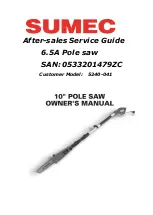
BASIC CUTTING PROCEDURE
■
Accelerate the engine to full throttle just before entering
the cut by squeezing the throttle trigger.
■
DO NOT use a back and forth sawing type motion for
cutting.
■
The following steps should be followed to prevent damage
to tree or shrub bark.
See Figure 7.
1. The first cut should be a shallow cut (1/4 of the limb
diameter) on underside of limb close to main limb or
trunk (A).
2. The second cut should be made from the top side of the
limb out wards from first cut (B).
3. Make the final cut close to trunk (C).
WARNING
To prevent possible serious injury to yourself or to
others, READ, understand, and follow all instructions
in this Operator's Manual.
■
Keep the engine at full throttle the entire time you are
cutting.
■
For second and final cuts (from top of limb or branch),
hold the front cutting guide (20) against the limb being cut.
See Figure 8. This will help steady the limb and make it
easier to cut.
■
Allow the chain to cut for you; exert only light downward
pressure. If you force the cut, damage to the bar, chain,
or engine can result.
■
Release the trigger as soon as the cut is completed,
allowing the engine to idle. If you run the pole pruner at full
throttle without a cutting load, unnecessary wear or
damage can occur to the chain, bar, and engine.
WORK AREA PRECAUTIONS
■
Cut only wood or materials made from wood; no sheet
metal, no plastics, no masonry, no non-wood building
materials.
■
Never allow children to operate your pole pruner. Allow no
person to use this pole pruner who has not read this
Operator's Manual and received adequate instructions for
the safe and proper use of this pole pruner.
■
Keep everyone - helpers, bystanders, children, and
animals a safe distance, of at least 50 ft. (15 m), from the
cutting area.
■
Always cut with both feet on solid ground to prevent being
pulled off balance.
■
Cut only when visibility and light are adequate for you to
see clearly.
LIMBING AND PRUNING
This unit is designed for trimming small branches and limbs
up to 6 in. (15 cm) in diameter.
■
Plan the cut carefully. Be aware of the direction in which
the branch will fall.
■
Branches may fall in unexpected directions. Do not stand
directly under the branch being cut.
■
The most typical cutting application is to position the unit
at an angle of 60° or less, depending on the specific
situation.
See Figure 9.
■
As the angle of the pole pruner shaft to ground increases,
the difficulty of making the first cut (from the underside
of limb) increases. Failure to follow procedure shown
in Figure 7 will result in the bar and chain binding
and becoming pinched or trapped in the limb. If this
should happen:
1. Stop the engine of the power head.
2. With engine stopped, loosen the knob on coupler.
3. Depress the button on the shaft, twist and pull the
shafts to separate the pruner from the engine.
4. If the limb can be reached from the ground, lift the limb
while holding the attachment. This should release the
"pinch" and free the pruner.
5. If pr uner is still trapped, call a professional for
assistance.
■
The long reach of the unit allows the operator to prune
branches or limbs that are normally out of reach.
■
Long branches should be removed in several stages.
■
Cutting lower branches first will allow the top branches
more room to fall.
■
Wor k slowly, keeping both hands on the saw with
a firm grip. Maintain secure footing and balance.
■
Keep the tree between you and the chain while limbing.
Cut from the side of the tree opposite the branch you
are cutting.
■
Do not cut from a ladder, this is extremely dangerous.
Leave this operation for professionals.
■
DO NOT use for felling or bucking.
■
When pruning trees it is important not to make the flush
cut next to the main limb or trunk until you have cut off the
limb fur ther out to reduce the weight. This prevents
stripping the bark from the main member. Under cut the
the branch 1/4 way through for your first cut, your second
cut should an over cut to drop the branch off. Now make
your final cut smoothly and neatly against the main
member so the bark will grow back to seal the wound.
See
Figure 7.
■
Keep all bystanders at least 50 ft. (15 m) away. To prevent
electrocution, do not operate within 50 feet (15 m) of
overhead electrical lines.
See Figure 11.
Under-Cut
Begin on the under side of the limb with the top of the pruner
against the limb; exer t light pressure upward. During
underbucking, the pruner will tend to push back at you.
Be prepared for this reaction and hold the pruner firmly to
maintain control.
7
English
OPERATION



































